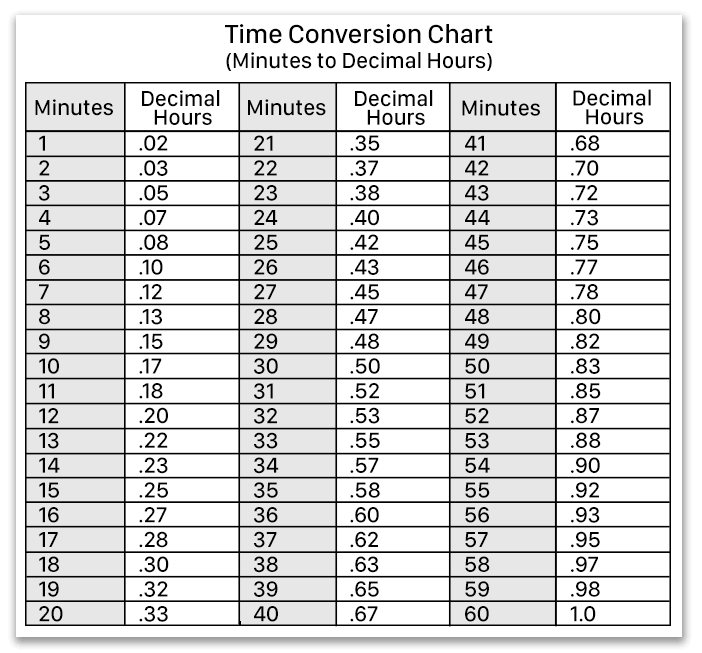Hours & Minutes Versus Decimal Time

Are you interested in how time is properly converted from hours and minutes to decimal format for payroll? We'll review and compare these two common formats for displaying and expressing time.
Note: Wondering if your totals are accurate? Read our brief article about the accuracy of timecard totals.
Hours & Minutes
The hours & minutes format uses 'base 60' to represent time. By this we mean that time is expressed in 60 one minute units. So when time is increased by one minute at 3:59, we don't write 3:60. Instead, we increase the hours by one and reset the minutes to zero and write 4:00. We express hours (60 minutes) and portions of an hour (minutes) with the format HH:MM. So whenever we see time expressed with a colon (:) we know that we are seeing time in the hours and minutes format.
Let's look at a simple example. 7:30 is read as 'seven hours and 30 minutes.' When we use this common expression of time we understand that it means seven periods of 60 minutes (7 hours) and one period of 30 minutes.
Decimal Hours
The decimal hours format uses 'base 10' to represent time as common decimal numbers. When we use decimal numbers each place in a number ranges from 0-9.
Using our 7:30 example above, we intuitively know that 30 minutes is 'half an hour.' In decimal format one-half is expressed as '.5'. So in decimal format this is expressed as 7.5 hours (7 and a half hours). When thought of in this way, it is not hard to understand that 7:30 (hours and minutes) = 7.5 decimal hours.
Hours for Payroll
Expressing time in decimal format is essential for payroll because wages must be calculated using standard decimal numbers. For example, how much have I earned if I make $10 per hour and work 7:30? I must convert 30 minutes to .5 decimal time before I multiply by my hourly wage. $10 x 7.5 hours = $75.
Converting Employee Hours
Some time conversions (like the one above) are intuitive. For instance, we know that:
- :15 minutes = quarter hour = .25 hours
- :30 minutes = half hour = .5 hours
- :45 minutes = three-quarters hour = .75 hours
But what about non-intuitive times? How do I convert 7:56 (seven hours and 56 minutes) to decimal time? Using the Time Conversion Chart below, we discover that 7:56 = 7.93 hours.

The chart above simply converts minutes from base 60 to base 10. Using our example of 56 minutes, we simply divide by 60 minutes: 56/60 = .93333333. Decimal hours are limited to displaying two decimal places, so the repeating 3 is rounded so that 56 minutes (:56) is expressed in decimal format as .93 hours.
Converting Time to Decimal Hours
We have several tools to assist you with converting hours between these two time formats:
- Our Free Decimal Hours Calculator effortlessly converts between hours and minutes and decimal hours.
- Our Free Time Card Calculator allows you to enter employee start, stop and break times in hours and minutes format. The calculator then computes the daily and weekly time totals in decimal format.
- Our Virtual TimeClock software impartially records employee start, stop and break times in real-time. The reporting features in Virtual TimeClock enable you to easily view reports either as hours and minutes for timecard review or decimal hours format for payroll.
About Redcort Software
Redcort Software is the publisher of by Virtual TimeClock, a powerful, easy to use program that simplifies time tracking, streamlines payroll, and empowers your workforce. Download a free trial of Virtual TimeClock to see it in action for yourself without any cost or obligation.